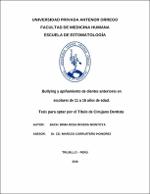Mostrar el registro sencillo del ítem
Bullying y apiñamiento de dientes anteriores en escolares de 11 a 16 años de edad.
| dc.contributor.advisor | Carruitero Honores, Marcos | |
| dc.contributor.author | Rivera Montoya, Irma Rosa | |
| dc.creator | Rivera Montoya, Irma Rosa | |
| dc.date.accessioned | 2019-04-03T22:21:56Z | |
| dc.date.available | 2019-04-03T22:21:56Z | |
| dc.date.issued | 2019 | |
| dc.identifier.other | T046_44796078_T | |
| dc.identifier.uri | https://hdl.handle.net/20.500.12759/4678 | |
| dc.description.abstract | El presente estudio tuvo como objetivo comparar el apiñamiento de dientes anteriores en escolares con y sin bulling. El estudio, prospectivo, transversal, comparativo y observacional se realizó en dos instituciones educativas, una pública y una privada, la cual estuvo constituida por 147 escolares de 11 a 16 años de edad. El apiñamiento dentario fue evaluado en el sector anterior superior e inferior en modelos de estudio, empleando el índice de irregularidad de Little. Para diagnosticar el bullying se aplicó un cuestionario previamente validado, con preguntas dicotomizadas. Al comparar ambos grupos se encontraron diferencias estadísticamente significativas en la cantidad de apiñamiento (p<0.05). Al comparar ambos grupos por sexo, no se encontraron diferencias estadísticamente significativas en la cantidad de apiñamiento (p>0.05). Según institución educativa, se encontraron diferencias estadísticamente significativas en la cantidad de apiñamiento en la institución pública (p<0.05) pero no en la privada (p>0.05). Se concluye que el apiñamiento dentario fue mayor en los escolares con bullying en comparación a los escolares sin bullying. Son necesarios estudios que evalúen el impacto del tratamiento del apiñamiento dentario en la disminución del bullying por apariencia de dientes en escolares. | es_PE |
| dc.description.abstract | The objective of the present study was to compare the crowding of anterior teeth in school children with and without bulling. The prospective, cross-sectional, comparative and observational study was carried out in two educational institutions, one public and one private, which consisted of 147 schoolchildren from 11 to 16 years of age. Dental crowding was evaluated in the upper and lower anterior sector in study models, using Little's irregularity index. To diagnose bullying, a previously validated questionnaire was applied, with dichotomized questions. When comparing both groups, statistically significant differences were found in the amount of crowding (p <0.05). When comparing both groups by sex, no statistically significant differences were found in the amount of crowding (p> 0.05). According to educational institution, statistically significant differences were found in the amount of crowding in the public institution (p <0.05) but not in the private one (p> 0.05). It is concluded that dental crowding was greater in schoolchildren with bullying compared to schoolchildren without bullying. Studies are needed to evaluate the impact of dental crowding treatment on the reduction of bullying due to the appearance of teeth in schoolchildren. | en_US |
| dc.description.uri | Tesis | es_PE |
| dc.format | application/pdf | es_PE |
| dc.language.iso | spa | es_PE |
| dc.publisher | Universidad Privada Antenor Orrego - UPAO | es_PE |
| dc.relation.ispartofseries | T_ESTO_577 | |
| dc.rights | info:eu-repo/semantics/openAccess | es_PE |
| dc.source | Universidad Privada Antenor Orrego | es_PE |
| dc.source | Repositorio institucional - UPAO | es_PE |
| dc.subject | Bullying | es_PE |
| dc.subject | Apiñamiento de dientes anteriores | es_PE |
| dc.subject | Índice de irregularidad | es_PE |
| dc.subject | Escolares | es_PE |
| dc.title | Bullying y apiñamiento de dientes anteriores en escolares de 11 a 16 años de edad. | es_PE |
| dc.type | info:eu-repo/semantics/bachelorThesis | es_PE |
| thesis.degree.level | Título Profesional | es_PE |
| thesis.degree.grantor | Universidad Privada Antenor Orrego. Facultad de Medicina Humana | es_PE |
| thesis.degree.name | Cirujano Dentista | es_PE |
| thesis.degree.discipline | Estomatología | es_PE |
Ficheros en el ítem
Este ítem aparece en la(s) siguiente(s) colección(es)
-
Estomatología [571]

